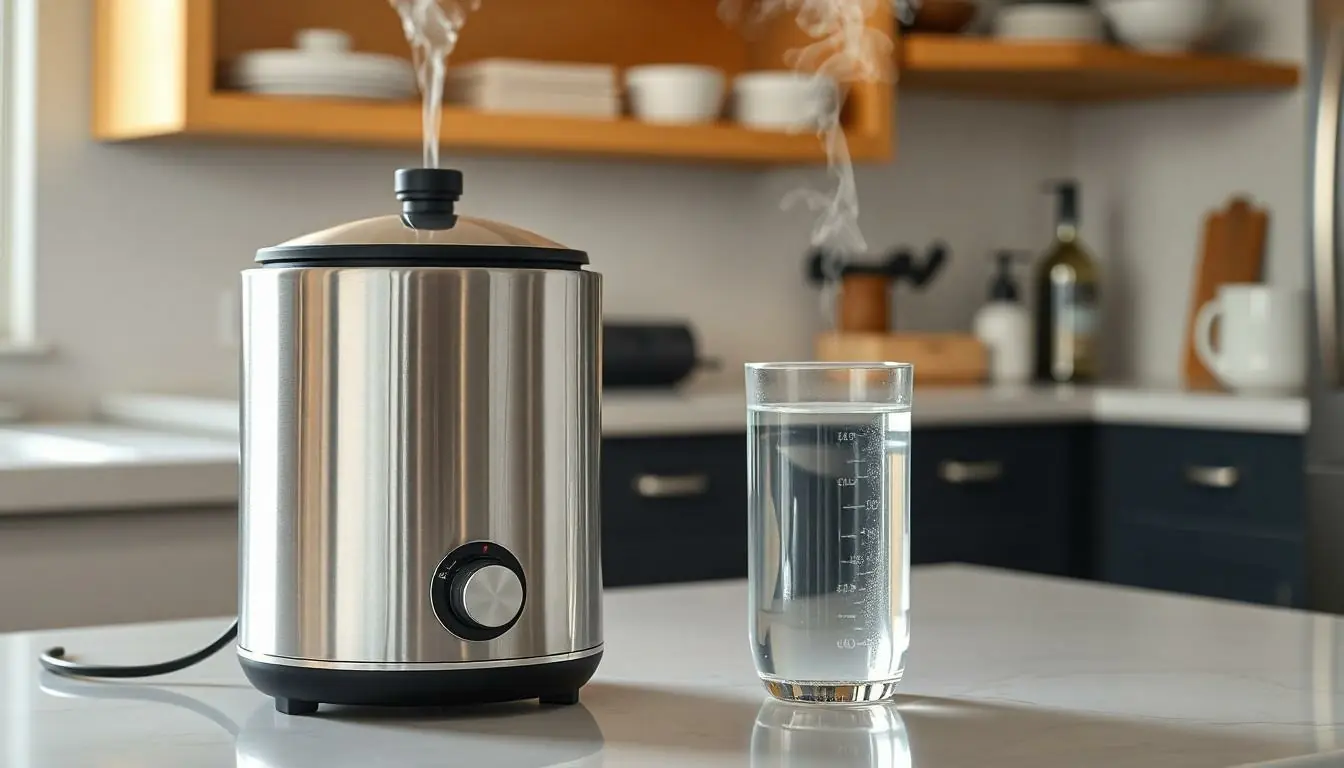Ever wondered how to turn your tap water into a crystal-clear elixir that even your houseplants would applaud? Making distilled water at home isn’t just a science project; it’s a fun and surprisingly simple way to ensure you’ve got the purest hydration possible. Say goodbye to those overpriced bottles and hello to your very own DIY distillery—minus the fancy lab coat.
Table of Contents
ToggleBenefits Of Distilled Water
Distilled water offers several health and practical benefits. It acts as an effective solvent, making it ideal for various applications, from cooking to cleaning. Many prefer it for drinking due to its purity, containing no contaminants, chemicals, or minerals.
The absence of minerals means distilled water eliminates the risk of exposure to harmful substances. This characteristic makes it a popular choice for individuals with sensitive stomachs or those aiming to avoid added chemicals. Pure hydration promotes better overall health and digestion.
In addition, distilled water plays a crucial role in appliances like steam irons and humidifiers. It prevents mineral buildup and extends the lifespan of devices, reducing maintenance needs. Households often appreciate this cost-saving aspect.
Distilled water finds favor in laboratories and medical settings for its consistency and reliability. Scientists and healthcare professionals utilize it in experiments and treatments, ensuring accurate results and minimizing contamination risks.
Gardening enthusiasts also value distilled water. They use it for watering sensitive plants and seedlings. The absence of dissolved solids ensures optimal growth conditions.
Home brewers recognize the benefits of using distilled water in beverage production. Its neutral taste allows for better flavor control when making beers and spirits. Enthusiasts mix it with other ingredients to enhance the final product.
Households can benefit from making distilled water at home. This DIY approach not only saves money, but also guarantees access to pure water whenever needed. Embracing this practice promotes sustainability and supports healthier lifestyles.
Methods To Make Distilled Water At Home
Making distilled water at home can be simple with a few methods to choose from. Each method offers an accessible way to ensure access to pure water for various needs.
Simple Stovetop Method
Start by filling a large pot with tap water. Place a heat-resistant bowl inside the pot, ensuring it floats on the water’s surface. Cover the pot with a lid turned upside down, allowing condensation to collect. Heat the water on medium heat, creating steam that condenses on the lid. Collect the distilled water in the bowl as it gathers. Check periodically to maintain water levels. This method is cost-effective and requires minimal equipment.
Electric Distiller Method
For a more efficient option, an electric distiller provides convenience. Fill the distiller’s reservoir with water, then turn it on. The device heats the water, producing steam that cools into distilled water. Most models include a built-in collection container for ease. This method often produces larger quantities quickly and minimizes manual effort, making it ideal for frequent use. Regular maintenance ensures optimal performance and longevity of the device.
Essential Equipment Needed
Making distilled water at home requires specific equipment for effectiveness and safety. Gather the necessary tools to ensure a smooth process.
Containers and Materials
A large pot serves as the primary vessel for the stovetop method. Add a heat-resistant bowl inside to collect steam. Use a lid to cover the pot; it facilitates condensation. For those opting for an electric distiller, ensure the unit has a container for collecting distilled water. A measuring cup helps in determining water levels. Choose materials that are free from contaminants to maintain purity.
Safety Precautions
Safety plays a crucial role in the distillation process. Always use heat-resistant gloves when handling hot containers. Position the pot securely on the stovetop to prevent spills. Monitor the water level; running it dry can damage equipment. Avoid contact with steam during the process; it can cause burns. If using an electric distiller, read the manufacturer’s instructions to prevent mishaps. Being mindful of these precautions promotes a safe and efficient distillation experience.
Common Mistakes To Avoid
One major mistake involves using contaminants in water. Always start with clean, filtered tap water to ensure purity. Ignoring the temperature settings can lead to problems; maintain a stable heat during the distillation process.
Some overlook the collection container’s material. Glass or stainless steel is preferred, as both avoid chemical leaching. Not monitoring water levels may cause the pot to dry out, damaging the equipment.
Another frequent error occurs with improper sealing of pots. Ensure that lids fit tightly to capture all steam effectively. Rushing through the process often leads to incomplete distillation; patience ensures maximum purity.
Neglecting safety precautions can result in burns. Use heat-resistant gloves when handling hot items and remain present during the entire process. Failing to follow manufacturer instructions with electric distillers might void warranties or lead to accidents.
Additionally, improper cleaning of equipment before use can lead to unwanted residues mixing. Thoroughly clean all tools to maintain a sterile environment. Lastly, attempting to distill water from sources like saltwater or chlorinated water isn’t advisable, as these contaminants will affect purity even post-distillation.
Conclusion
Making distilled water at home not only offers a cost-effective solution but also ensures access to pure water for various needs. By following simple methods and safety precautions, anyone can enjoy the benefits of distilled water for drinking, cooking, and maintaining appliances. Embracing this DIY approach fosters sustainability and promotes a healthier lifestyle. With the right tools and knowledge, individuals can take control of their hydration and contribute to a cleaner environment. Distilled water is more than just a beverage; it’s a versatile resource that enhances everyday life.





